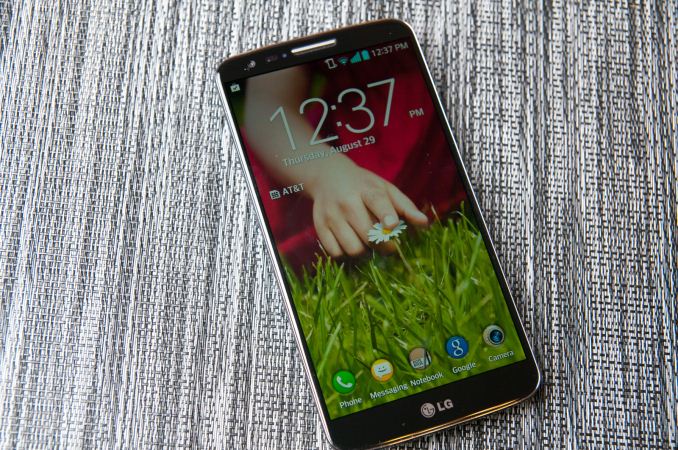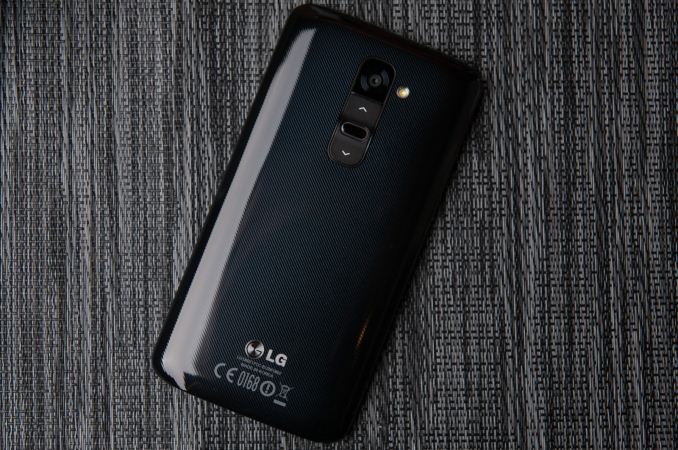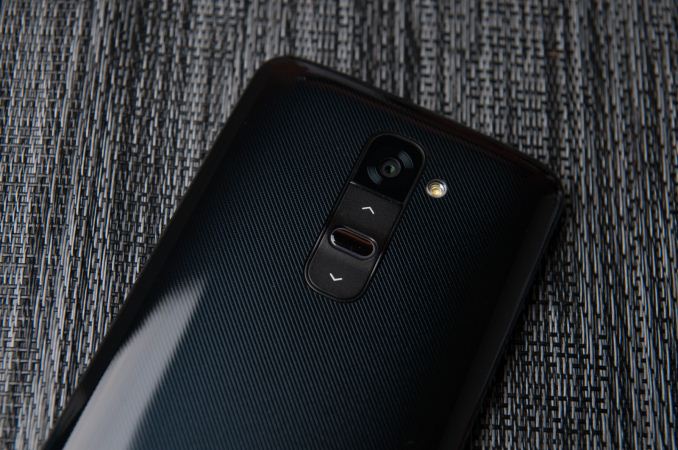LG G2 and MSM8974 Snapdragon 800 - Mini Review
by Brian Klug on September 7, 2013 1:11 AM EST- Posted in
- Smartphones
- LG
- Mobile
- LG G2
- Android 4.2
- MSM8974
- Snapdragon 800

The LG G2 is the spiritual successor to the Optimus G, a device that we looked at last year and eventually went on to become the Nexus 4. LG dropped the "Optimus" branding this time, but the G2 is without a doubt still LG's flagship smartphone, and includes a number of unique LG features – stacked 3000 mAh (11.4 Whr) battery with SiO+ anode, 5.2-inch 1080p LCD from LG Display, and 13 MP rear facing camera with OIS (Optical Image Stabilization). It's an impressive combination of features that make the G2 a standout device. At the same time the G2 is our first chance to get a look at the 2.3 GHz bin of Snapdragon 800 inside a shipping device and get a look at performance and battery life.
We took a quick look at the G2 at the announcement event, now we have our hands on a G2 and have been putting it through its paces, benchmarking it, and running battery life tests on it for a little under a week and wanted to share some thoughts.
Hardware Impressions
The G2 marries a curved backside shape with front glass that slightly curves at the edges and has a very narrow side bezel. The G2 also opts for on-screen buttons rather than the discrete capacitive kind or physical buttons that went out of favor a while ago. The reality is that Google does have a fair amount of input into at least this part of the Android ecosystem, and its guidance seems to be that on-screen buttons which use display real estate to draw the buttons is the recommended way to go. The G2 does afford the ability however to add Quick Memo buttons or the notification shade pull down/pull up buttons to the bar, but oddly enough there's no multitasking button option available.
The G2 manages to include a large display without width that's much different from other devices I've been using lately, like the HTC One. Part of getting the edge bezel small was a reduction in volume required on the sides for volume and power buttons, which are instead moved to the back of the G2, perhaps its most striking and initially even alarming design change.
Holding down the volume down button launches you into the camera, pressing the center button powers on the phone, and holding down the top button launches QuickMemo. Up and down are volume up and down otherwise. There's a hard raised lip on both sides of the button too, so the G2 when laid backside down on a surface makes contact there instead of on the button – it won't inadverntely turn on when pressed against a table. I found the backside buttons easy to adapt to after my first few interactions with the G2, and they actually become second nature after a day or so. The raised bump for the power button makes it easy to locate with the index finger, and I haven't smeared or accidentally put my finger on the sapphire camera cover yet. If the power button on the back is still difficult to get used to, the G2 has a double tap to turn on feature it calls "knock knock" – double tap on the display, and the G2 will turn on, repeat the double tap on the status bar or in an empty part of the display when it's on, and it turns off. I find myself using the double tap gesture quite a bit to turn the G2 on and off. I believe this functionality uses the sensors onboard and the DSP inside 8974 to detect when the taps occur.
The G2 I was sampled is a dark blue color which has a slight pinstripe on the back as shown in the photos above. The material is however the same kind of glossy plastic I'm used to seeing out of the Korean handset makers of note, and picks up fingerprints and hand oil very quickly unfortunately. I like the shape of the device and LG's innovations, it's just puzzling to me that materials hasn't picked up yet, I'd even take glass from the Optimus G over plastic. I'll save you the huge discussion on device size as well, I'm fine with the larger smartphones that aren't quite phablets, and the G2 for me is totally usable and I appreciate the increased display size. It definitely isn't phablet size, but it is on the larger high-end smartphone side of things.
| LG G2 | |
| SoC |
Qualcomm Snapdragon 800 (MSM8974) 4x Krait 400 2.3 GHz, Adreno 330 GPU |
| Display | 5.2-inch IPS-LCD 1920x1080 Full HD |
| RAM | 2GB LPDDR3 800 MHz |
| WiFi | 802.11a/b/g/n/ac, BT 4.0 |
| Storage | 32 GB internal |
| I/O | microUSB 2.0, 3.5mm headphone, NFC, Miracast, IR |
| OS | Android 4.2.2 |
| Battery | 3000 mAh (11.4 Whr) 3.8V stacked battery |
| Size / Mass | 138.5 x 70.9 x 9.14 mm |
| Camera |
13 MP with OIS and Flash (Rear Facing) 2.1 MP Full HD (Front Facing) |



















120 Comments
View All Comments
Paulman - Saturday, September 7, 2013 - link
"<b>WOW...</b> wow.... wow, wow..." - That's literally what came out of my mouth when I first saw those battery life graphs. Amazing, LG. GG WPPaulman - Saturday, September 7, 2013 - link
"Gone are the days of 1.4V to hit near-2GHz frequencies it seems, instead 8974 will hit 2.3 GHz at around 1V." - That elicited another 'Wow' from me.andykins - Saturday, September 7, 2013 - link
That is an insane difference. But is there some downside too? Seems a bit good to be true.Froyorkshire - Saturday, September 7, 2013 - link
Heat, most likely. The LG G2 seems to have it taken care of but if the Nexus 4 was any indication, the Nexus 5 needs to have a better-engineered body to handle the S800's potential heat.tuxRoller - Saturday, September 7, 2013 - link
Why would you have more heat when pushing less V and A? Yes, it is clocked higher and has a more powerful gpu so its tdp (or whatever) will be higher than s600 soc, but at the same clocks as the pre-800s it should use less power.This shouldn't be a surprise since this is, apparently, the first time snapdragons have used 28nm hpm, and with new processes come inherent advantages (also problems, but heat shouldn't be one of them unless you are running it at full-tilt).
theduckofdeath - Sunday, September 8, 2013 - link
They reduce the voltage to reduce the wattage, which is what heat is generated from.gwydionjhr - Saturday, September 7, 2013 - link
The side by side comparison video is very interesting. I've only have a light understanding of what I'm seeing, and if you get a chance, I'd really love to get your impressions on how each of these OIS/EIS systems perform. The one question that came to me as my eyes darted back and forth tying to compare the two videos, was that the 1020 OIS seemed to work pretty well, right up to the moment of impact on your footfall. I'm I seeing that right? Is this a result of the weight of the larger sensor in the 1020 maxing out the capabilities of the OIS when those large acceleration forces hit it?Brian Klug - Saturday, September 7, 2013 - link
Accommodation angle is the big game, and they're all also tuned differently too it seems. I'm not walking very aggressively or stomping around either, but trying to walk normally. I wanted to include the Lumia 920 as well but didn't bring it, the 925 seems to be pretty similar to what I remember the 920 being like though.-Brian
UpSpin - Saturday, September 7, 2013 - link
It's funny that in my opinion the 1020 (and so also the 808) does one of the worst jobs in OIS, the 925 the best followed by the HTC One and Moto X. Between them is the rest. LG2 on par with the 1020, in some scenes worse, in some better.In the 1020 vs. 925 comparison, at the beginning, Brian walks along a footway, the 1020 video has a very obvious and penetrant periodic shaking/reflex which does not exist in the 925 or HTC One video.
At the very beginning of the Moto X comparison we see a handrail with a building behinde it, the Moto X video is sharp and steady, the 1020 video wobbles in the z-direction
The colors in the 1020 are the most vivid ones, but in my opinion also the most over saturated and artifical ones. It does a good job in capturing the blue of the sky, but therefore darker details aren't visible on the 1020 videos. (handrail at the end of the test videos)
It's obvious that using a larger sensor a OIS is harder to implement, but I find it odd that Nokia hasn't made any use of the 41MP in video recording mode by additionally implementing an EIS.
But I found it surprising how good or even better the competition is (or how bad the 1020 in videos is), using a cheaper and less intrusive sensor. (in photos the 1020 will probably (and hopefully) remain unbeaten)
Krysto - Sunday, September 8, 2013 - link
It seemed to me the LG one beat the 1020 OIS slightly. The 920 one was the best though, as Brian said. But 920 had far from accurate colors.